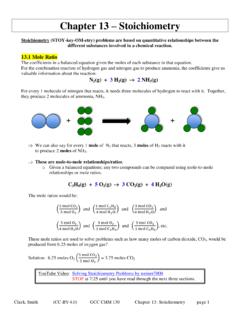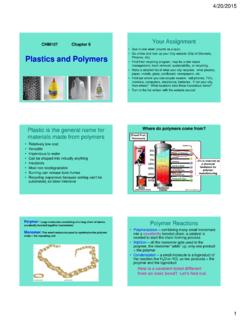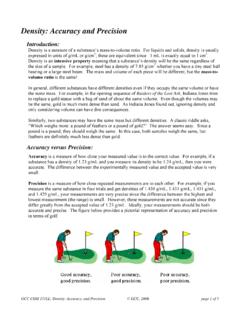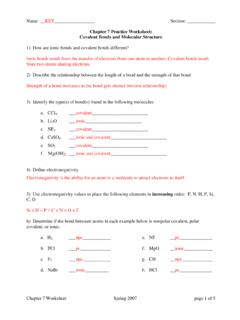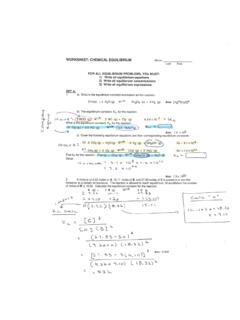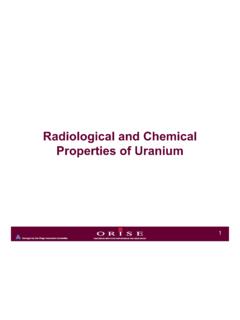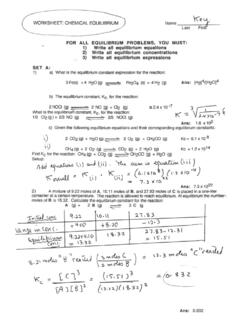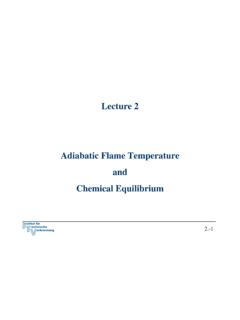Transcription of Chapter 14. CHEMICAL EQUILIBRIUM
1 Chapter 14 EQUILIBRIUM Notes page 1 of 6 Chapter 14. CHEMICAL EQUILIBRIUM THE CONCEPT OF EQUILIBRIUM AND THE EQUILIBRIUM CONSTANT Many CHEMICAL reactions do not go to completion but instead attain a state of CHEMICAL EQUILIBRIUM . CHEMICAL EQUILIBRIUM : A state in which the rates of the forward and reverse reactions are equal and the concentrations of the reactants and products remain constant. EQUILIBRIUM is a dynamic process the conversions of reactants to products and products to reactants are still going on, although there is no net change in the number of reactant and product molecules. For the reaction: N2O4(g) 2NO2(g) The EQUILIBRIUM Constant For a reaction: aA + bB cC + dD EQUILIBRIUM constant: Kc = badcBADC][][][][ The EQUILIBRIUM constant, Kc, is the ratio of the EQUILIBRIUM concentrations of products over the EQUILIBRIUM concentrations of reactants each raised to the power of their stoichiometric coefficients.
2 Example. Write the EQUILIBRIUM constant, Kc, for N2O4(g) 2NO2(g) Law of mass action - The value of the EQUILIBRIUM constant expression, Kc, is constant for a given reaction at EQUILIBRIUM and at a constant temperature. The EQUILIBRIUM concentrations of reactants and products may vary, but the value for Kc remains the same. Other Characteristics of Kc 1) EQUILIBRIUM can be approached from either direction. 2) Kc does not depend on the initial concentrations of reactants and products. 3) Kc does depend on temperature. Magnitude of Kc If the Kc value is large (Kc >> 1), the EQUILIBRIUM lies to the right and the reaction mixture contains mostly products. If the Kc value is small (Kc <<1), the EQUILIBRIUM lies to the left and the reaction mixture contains mostly reactants. If the Kc value is close to 1 ( < Kc < 10), the mixture contains appreciable amounts of both reactants and products.
3 Ratetime Forward rate Reverse rate concentration time N2O4 NO2 Chapter 14 EQUILIBRIUM Notes page 2 of 6 WRITING EQUILIBRIUM CONSTANT EXPRESSIONS Calculating EQUILIBRIUM Constants, Kc Kc values are listed without units don't include units when calculating Kc. If EQUILIBRIUM concentrations are known, simply substitute the concentrations into the EQUILIBRIUM constant expression: Example. For the reaction, CO + 3H2 CH4 + H2O, calculate Kc from the following EQUILIBRIUM concentrations: [CO] = M; [H2] = M; [CH4] = M; [H2O] = M. Homogeneous equilibria: reactants and products exist in a single phase. For the gas phase reaction: N2O4(g) 2NO2(g) The EQUILIBRIUM constant with the concentrations of reactants and products expressed in terms of molarity, Kc, is: Kc = ]ON[]NO[4222 Gas Phase Expressions can also be expressed by Kp The Kp expression is written using EQUILIBRIUM partial pressures of reactants & products.
4 For the reaction given above, the Kp expression is: Kp = 422ON2 NOPP Kp is related to Kc Since pressure and molarity are related by the Ideal Gas Law, the following equation relates Kp and Kc: Kp = Kc(RT) n where R = molKatmL ; T = temperature in Kelvin n = moles of gaseous products moles of gaseous reactants Note that Kc = Kp when the number of gas molecules are the same on both sides. Example. Does Kc = Kp for (a) H2(g) + F2(g) 2HF(g)? (b) 2SO2(g) + O2(g) 2SO3(g)? Example. For the reaction, 2SO2(g) + O2(g) 2SO3(g) (a) write the EQUILIBRIUM constant expression, Kp. (b) What is the value for Kp if Kc = at 1000 K? Heterogeneous Equilibria and Solvents in Homogeneous Equilibria Heterogeneous equilibria: reactants and products are present in more than one phase. Chapter 14 EQUILIBRIUM Notes page 3 of 6 pure solids and liquids: concentrations of pure solids and liquids are fixed by their density and molar mass (both constants) and do not vary with the amount.
5 []MassMolarDensityM== gmolLmlmlgLmolM ==1103 Thus, the concentrations of solids and liquids are incorporated in the Kc value; they are not part of the variable Kc expression: Example. Write the Kc expression for CaCO3(s) CaO(s) + CO2(g) Omit concentration terms for solids and liquids from Kc and Kp expressions; only include terms for gases (g) and aqueous substances (aq). Example. Write the Kc expression for the following reaction: 3Cu(s) + 2NO3-(aq) + 8H+(aq) 3Cu2+(aq) + 2NO(g) + 4H2O(l) Modifying EQUILIBRIUM Constant Expressions: A. Changing stoichiometric coefficients: 1) 2SO2 + O2 2SO3 K1 = 2) SO2 + 21O2 SO3 K2 = If we multiply an equation by a factor, we must raise its K to that power to get the new K. B. Reversing the reaction: 3) 2SO3 2SO2 + O2 K3 = K is the reciprocal of the K value for the reverse reaction.
6 C. Adding Equations for Multiple EQUILIBRIUM Reactions: 1. A + 2B C K1 = 2. A + D B K2 = 3. 2A + B + D C K3 = When we add equations to get a new equation, the new K is the product of the other K s. Example. 2H2(g) + O2(g) 2H2O(g) Kc = N2(g) + 3H2(g) 2NH3(g) Kc = Calculate the value of Kc for 4NH3(g) + 3O2(g) 2N2(g) + 6H2O(g) Chapter 14 EQUILIBRIUM Notes page 4 of 6 THE RELATIONSHIP BETWEEN CHEMICAL KINETICS AND CHEMICAL EQUILIBRIUM For the reaction N2O4(g) 2NO2(g) Rate of forward reaction = Rate of reverse reaction kf[N2O4] = kr[NO2]2 Rearrange: ][][4222 ONNO= rfkk = Kc Thus, the EQUILIBRIUM constant is simply the ratio of the forward and reverse rate constants which are both constant values at a given temperature.
7 WHAT DOES THE EQUILIBRIUM CONSTANT TELL US? Predicting the Direction of Reaction The reaction quotient, Q, is the resulting value when we substitute reactant and product concentrations into the EQUILIBRIUM expression. 1. If Q > K, the reaction will go to the left. The ratio of products over reactants is too large & the reaction will move toward EQUILIBRIUM by forming more reactants. 2. If Q < K, the reaction will go to the right. The ratio of products over reactants is too small & the reaction will move toward EQUILIBRIUM by forming more products. 3. If Q = K, the reaction mixture is already at EQUILIBRIUM , so no shift occurs. Example. For the reaction, B 2A, Kc = 2. Suppose moles of A and moles of B are introduced into a L flask. (a) In which direction will the reaction proceed to attain EQUILIBRIUM ?
8 (b) Will the concentration of B increase, decrease or remain the same as the system moves towards EQUILIBRIUM ? Calculating EQUILIBRIUM Concentrations Use ICE Tables To Solve EQUILIBRIUM Problems For Kc Or EQUILIBRIUM Amounts: 1. I = initial concentration: Initial concentration of reactants are usually given; initial [Product]'s are assumed to be 0 unless otherwise specified. 2. C = change in concentration: Assign change as the variable x; use the stoichiometry of the reaction to assign changes for all species. 3. E = EQUILIBRIUM concentration: E = I + C Note, values in ICE tables can be in terms of moles or Molarity (or atm for Kp), but values used in the Kc expression must be in terms of Molarity (or atm for Kp). Chapter 14 EQUILIBRIUM Notes page 5 of 6 Example.
9 When mol SO2 and mol O2 are placed in a L vessel at 1000 K, the EQUILIBRIUM mixture was found to contain mol SO3. Calculate Kc for this reaction: 2SO2(g) + O2(g) 2SO3(g) Method to find EQUILIBRIUM concentrations 1) Set up the ICE table. 2) Set up the Kc expression; substitute EQUILIBRIUM concentrations from the ICE table into Kc. 3) Solve for x; plug the solution for x back into the EQUILIBRIUM concentration expressions. Perfect square problem to solve for x Take the square root of both sides when the math expression is a perfect square. Example. At 430 C, Kp = for the following reaction: H2(g) + I2(g) 2HI(g) A mixture of H2 at a pressure of atm and I2 at a pressure of atm is placed in a container at 430 C. Calculate the EQUILIBRIUM partial pressures of HI, H2 and I2.
10 Quadratic Formula Example For this reaction, H2(g) + F2(g) 2HF(g), Kc = at a certain temperature. Suppose moles of H2 and moles of F2 are placed in a L container. What are the EQUILIBRIUM concentrations of H2, F2 and HF? Chapter 14 EQUILIBRIUM Notes page 6 of 6 FACTORS THAT AFFECT CHEMICAL EQUILIBRIUM Le Chatelier's Principle: If a system at EQUILIBRIUM is disturbed by an external stress, the system adjusts to partially offset the stress as the system attains a new EQUILIBRIUM position. Changes in Concentration Adding a reactant or product, the equilibria shifts away from the increase in order to consume part of the added substance. Removing a reactant or product, the equilibria shifts toward the decrease to replace part of the removed species.

